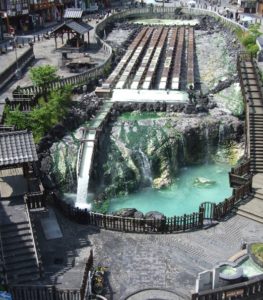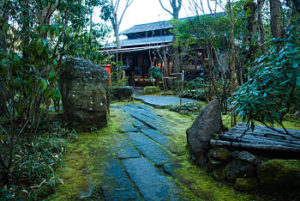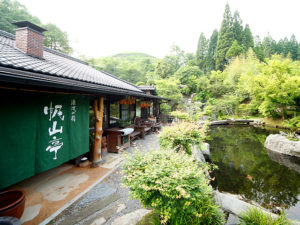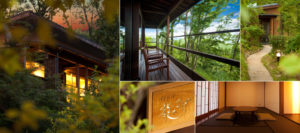Origin 原點
The origin of the trip took on several evolutions over the course of almost a year. Ever since the last trip back in October the year before, it was decided that the next time I took my parents on a trip it will be have to be at a leisurely pace. Dad is not young anymore and he gets tired easily in the afternoon.
這次旅遊的原構思在將近一年中經歷了多次演變。從上回在去年十月的旅行後,就決定下次帶爸媽將採取非常悠閒的步調。老爸不年輕了,下午常會感到疲倦。
The answer that comes to mind easily is then onsens. Despite having been to Japan many times I have yet to stay at a proper onsen town. Yatsusan Kan in Hida had onsen but wasn’t well known, the visits to Tamatsukuri Onsen near Matsue and Toya-ko Onsen in Hokkaido were day trips without staying overnight.
直接想到的答案很清楚,溫泉。雖然去過日本數次,仍沒有在真正的溫泉街住過。飛騨的八三館有溫泉但不有名,逛過的松江附近的玉造溫泉和北海道的洞爺湖溫泉都只是當天來回,並沒有過夜。
The date was chosen to be in either autumn or near end of year as summer can be too hot for onsens, plus it coincided with relative’s wedding in Taiwan. Preliminary plans was for 4-5 days with 2 nights of onsens.
日期定在秋天或接近年底。夏天泡湯可能有點熱,同時也可參加台灣親戚的婚禮。初步規劃定調為4-5天,2晚住溫泉。
Picking the Onsen 選則溫泉區
Scouting a suitable onsen proved more difficult than imagined. The original list began with onsens accessed via Tokyo, ones in east central Japan and north eastern Japan with good shinkansen access. Tokyo have many lovely xmas light decorations starting in December so this was a good night time activity for the day of arrival and day before departure.
實際尋找適合的溫泉區比想像中的困難許多。原名單是從東京交通的溫泉,從日本中部東側到東北,搭新幹線可到的溫泉。東京12月有許多美麗的聖誕燈飾,作為抵達當晚和離開前一晚必須待在市區的景點再適合不過。
Snow was a plus, though November/December the chances were maybe 50/50. The obvious choices were then Kusatsu (草津), Kinugawa (鬼怒川), Nasu (那須), Kawaguchi-ko (河口湖), Hakone (箱根), Karuizawa (軽井沢) (and the smaller onsens around the area).
有雪景更好,不過11/12月大概只有一半機率。最想當然爾的選擇是草津,鬼怒川,那須,河口湖,箱根,軽井沢(還有這幾區附近的小溫泉)。
Ginzan (銀山), Zao (蔵王), Shirahone (白骨), Yudanaka (湯田中) the Monkey Onsen , Nyuto (乳頭) were also considered shortly before deemed too out of the way given the short trip.
也有考慮過銀山,藏王,白骨,湯田中-猴子泡溫泉,乳頭,等溫泉,不過考慮行程短暫稍嫌遠了點。
Open air onsen was a requirement and the ryokan must not be too big else the public onsen may become crowded. Heavy considerations were given to ryokans with rooms that came with their own private open air onsen, later this would turn more of a prerequisite.
露天溫泉是基本要求,旅館也不能太大不然公共溫泉可能會太多人。評估時房間有私人露天溫泉的旅館為優先,這點之後慢慢變成考慮旅館的前提。
The other consideration was that the onsen should be kakenagashi (掛け流し), meaning the onsen water is not recycled and with minimal water added.
另一個考慮的重點是溫泉掛流,也就是溫泉水不回收循環,也不添加多餘的水。
The plan concentrated around two options. Hakone + Kawaguchi-ko or Karuizawa + Kusatsu. Kinugawa and Nasu were ruled out as there were no desirable ryokans (and I would later find out they are notorious onsen derelict towns, I might talk about them later as my search branched into an onsen town development research)
規劃上逐漸集中成兩種選擇。箱根+河口湖或軽井沢+草津。鬼怒川和那須因沒有適當的旅館排除 (之後會發現兩者其實是有名的廢墟溫泉鎮。我後來研究行程時岔題成了研究溫泉街道發展史)
I turned over every ryokan in the onsen towns, trying to get a feel of their room and onsen. Over a hundred ryokans must had been researched and twenty or so seriously considered. Two practical plans were formed, one each for the mentioned routes, and the choice of onsens down to 1-2 for each town in the route. There was a ryokan in Kusatsu, Toki no Niwa (季の庭) which ran a shuttle bus from Karuizawa, this would have saved over a 1000 yen per person, time saving and incredibly appealing. Also Karuizawa have a very famous and beautiful xmas lighting in one of the resort’s church.
我翻遍了溫泉區的每家旅館,摸索他們房間和溫泉的樣子。研究的旅館大概有一百間,嚴肅考慮過二十多家。發展出兩個可行的方案,分別為之前提過的兩種跑法,每個地點的旅館也篩選到剩一兩家了。草津有一家旅館季の庭有從軽井沢的接送車,省超過1000Y的車錢也省時間,非常吸引人。同時,軽井沢有一個渡假村的教堂的聖誕燈飾非常漂亮有名。

草津温泉 Kusatsu Onsen, source wiki
Technically I had already completed initial trip plans and was well into refinement stage, identifying exact transport timings and sightseeing attractions. But there was always something missing. The schedules never quite matched, the trains were always just a little too late or early, the time it took to move to and from the onsens were just a little too long, edging into exhausting and possibly not worthwhile with inadequate time for sightseeing.
我嚴格上已經做好了初步規劃,進入到處理交通時間和景點等細節的階段了。但總覺得好像缺少什麼。行程表總是對不起來,電車時刻總是太晚或太早,來往溫泉所花的時間太多一點,顯得有點累人,也可能壓縮到觀光時間不值得。
Several tweaks were attempted, shifting the order of the locations and attractions. In the end I took the decision to give up 2 months of planning, go back to square one and start again from picking out an entry area.
嘗試修改過幾次,改變地點景點順序。但最後還是決定放棄已經投入2個月的規劃,從新回到原點從找進入日本的地點開始。
Nagoya was immediately ruled out. Gero Onsen is boring and Oku-Hida Onsen is too far (plus we’ve already been to Takayama).
名古屋無須考慮,下呂溫泉沒什麼好玩的,奧飛騨溫泉太遠(也去過高山了)。
Kansai was given some thoughts but again ruled out. Kinosaki Onsen is good, the rest not so much. Shirohama in Wakayama is too far and seaside onsen in winter? Not good. Arima is a tourist sardine can. The rest of onsens were also ruled out for various reasons.
關西有稍微想過,但也排除。城崎溫泉不錯,但剩下的就不怎麼樣。和歌山的白浜稍嫌太遠,冬天在海邊也不好。有馬一堆觀光客擠沙丁魚。其他的溫泉也不考慮。
That left Kyushu.
剩下的只有九州了。
When it came to Kyushu, the onsen choice is easy. The standard triple onsen course following the Kyushu Crossing: Begin from Kumamoto, Kurokawa Onsen, Yufuin Onsen, Beppu Onsen then return to Hakata.
說到九州溫泉選擇倒是很簡單。最基本的溫泉三冠走法,循著九州橫斷從熊本出發
,黑川溫泉,由布院溫泉,別府溫泉,然後回博多。
Beppu was chucked out as there was only budget for 2 nights (3 nights of onsen is also a little too much for the body).
只有2晚溫泉的預算先去掉別府(連泡3晚溫泉對身體負擔也太超過了)。
Given the highly standard nature of the course, planning could not be any easier. Day 1: Shinkansen to Kumamoto. Day 2: Take Aso Boy train to Aso, take a quick look around Aso then bus to Kumamoto. Day 3: Tour Kurokawa then bus to Yufuin. Day 4: Tour Yufuin then take Yufuin no Mori train back to Hakata. Simple, easy as pie.
由於是最標準的行程規劃上是再容易不過了。第一天搭新幹線到熊本,第二天搭阿蘇男孩到阿蘇,稍微逛逛後搭巴士去黑川。第三天逛黑川後巴士去由布院,第四天逛完由布院搭由布院之森會博多。簡單。
Simple is not an appropriate adjective for this trip.
這趟旅遊可是分毫不能用簡單來形容。
The Earthquake 地震
The Kumamoto earthquake in April threw everything into chaos.
四月的熊本地震打亂了一切。
The earthquake destroyed the roads and rails between Kumamoto and Aso/Kurokawa and also severely damaged the famous Kumamoto Castle, one of the key attractions in that city, and had to be sealed off. Given the effect this had on transportation, with rail severed and the bus taking long detours on a reduced timetable, it seemed obvious to drop Kumamoto and Aso entirely and look to head directly to Kurokawa from Hakata.
地震震毀了熊本和阿蘇黑川之間的道路和鐵道,熊本的主要觀光景點熊本城也受到嚴重傷害被封鎖了。在火車不通,巴士也需繞道且減班的情形下,很明顯的只能捨棄熊本和阿蘇,尋找直接從博多到黑川的方案了。
However the bus from Hakata to Kurokawa takes about 3 hours, and arrive in Kurokawa quite late, so I looked to break the journey by removing the night at Yufuin and replacing it with a night’s stay at Amagase on the first day, whose ryokan Tensui (天水) looks to be quite highly rated.
但是從博多到黑川的巴士需要3小時,到黑川的時間也很晚,所以我考慮是否將由布院的住宿改到第一天,往黑川中途的天瀬。這裡有家叫天水的旅館看來評價不錯。

Tensui 山荘天水 src: www.tensui.net
On surface this looked like a good plan, deep down this never sat well. Breaking the journey this way compressed time in Yufuin quite severely, down to maybe 3 hours only. Also Tensui is not a well known ryokan and I could not figure out what its private room onsens were like from promotional photos.
表面上這計畫不錯看起來,但仔細想時總覺得不太穩當。不但壓縮到逛由布院的時間,可能會只剩不到3小時,天水也不是有名氣的旅館,我總是無法從宣傳照片上猜出他房間的溫泉長什麼樣子。
A tedious search was launched on youtube and japanese blogging sites to ascertain a better picture of the rooms. All while the plan for Kurokawa + Yufuin continued.
我開始在youtube和日本部落格上尋找房間的相片。同時也繼續規劃著黑川+由布院的選項。
Choice of ryokan, at least for Kurokawa is straightforward. Hozantei (帆山亭) was the top choice given its private onsen rooms (only a handful in Kurokawa has private onsens, and fewer has riverside views). There’s also Yamamizuki (山みず木) and Ryokan Sanga (旅館 山河). Either way there’s only 2-3 to consider.
在選旅館上,至少在黑川方面並不複雜。看在他房間的私人風呂,帆山亭是首選 (黑川房間有風呂的不多,可看河的更少)。另外來有山水木和旅館山河。總之符合條件的不超過2-3間。

Hozantei 帆山亭 src: www.hozantei.com
It was good that research was made as it turned out Tensui’s private baths were not too big and lacked changing area.
幸好有深入研究,才發覺天水房間的風呂並不大,也缺乏脫衣間。
Around June the plan to stay at Amagase was abandoned and efforts were refocused around getting from Hakata directly to Kurokawa then a stay at Yufuin. The thought of using rental car entered consideration due to this.
六月左右時正式放棄住天瀨的計畫,集中安排從博多直達黑川然後住由布院的方法,也開始有了考慮租車自駕的想法。
Yufuin Ryokan 由布院的住宿
Hozantei had been chosen for Kurokawa and for Yufuin, Bettei Itsuki (別邸 樹) was originally the top choice. Bettei Itsuki follows the popular hanare (離れ) concept for hotels and ryokans in Yufuin, each room is its own separate cabin with its own private baths, spacious and quiet, free from disturbances from other guests. Bettei Itsuki is especially popular amongst foreigners, probably because of its multilingual website and just general word of mouth. Each room is also ~20k yen per person only, which is fairly cheap compared to other hotels with similar cabin rooms.
黑川的住宿已選是帆山亭,而由布院一開始首先考慮的是別邸 樹。別邸 樹走的是在由布院挺流行的離屋概念,每間房間都是獨棟的屋子,擁有自己的風呂,房間寬廣,安靜,不受其他住客影響。別邸 樹在外國人中格外出名,或許是他官網有多國語言,加上網路上互傳分想就越來越有名了。每間每人大約只要兩萬日圓,和其他離屋概念的住宿比相較下便宜。
Bettei Itsuki is not without its catch however. First is its variety of rooms, each room has its own layout and deco style. On its own this variety seems like a good thing until one digs a little more. Each room is not created equally, not even of the same size, one does not even has outdoor bath (some room has two, why??). Then consider that they do not allow specifying which room when one books using the internet (can only specify which room by phone). This means either booking by phone (which is very annoying), or take a gamble and book on the net.
別邸 樹不是沒有陷阱的。首先是他每個房間都不同,有不同的格局和裝潢風格。這原本不是什麼壞處,但稍微探討後就會發覺問題所在。每間房間並不同等級,大小不一,有一間甚至沒有戶外風呂(有的卻有兩個風呂,天知道為什麼)。再加上他們網路訂房時不接受指定房間(只能透過電話預約指定)。這樣就只能透過電話預約(但很麻煩),或是就網上訂房賭分到好的房間。
Apart from the room roulette, the next catch is it does not serve traditional Japanese breakfast, opting for western style breakfast instead. This is a huge hidden saving on their part as a good traditional Japanese breakfast can run several k above a western breakfast. As for dinner, depending on the main selected there’s also some complaints about the portions being too small. Looking at the menus shared by others there are certainly less dishes compared to a typical kaiseki.
除了房間賭盤外,下個陷阱是他的早餐不是傳統日式早餐,而是西式的。這是經營者省錢的暗步,一個高級的傳統日式早餐和西式比可能貴數千日圓。在晚餐方面,看主餐選什麼有些人也反應說分量不太夠。看其他人分享的菜單,樣數的確比其他懷石少。
Lastly Bettei Itsuki is a little shifty about whether their onsen is in fact kakenagashi. A lot of blogs talk about it being kakenagashi but this is not mentioned anywhere on their official site nor on booking websites. This raises a few eyebrows as it seems like a good marketing point. Through various comments and posts I pieced together that they (and many other ryokan, including the one I was originally considering for Kusatsu) probably sit in a grey area of kakenagashi.
最後則是別邸 樹並沒有表明自己的溫泉是否是掛流。雖然許多部落格分享時提到他是掛流但這在官網或訂房網上並沒有提。這相當令人起疑,因為掛流該是很好的宣傳要點。在看過各種評價和分享後我大致揣測出他(和其他許多旅館,包含我之前草津考慮的那家)可能位於掛流的灰色地帶。
While they do not recycle the onsen water, they do not have enough onsen water to supply every room continuously. So they either ask that the onsen water be turned off during night time (people complained that the onsen was too cold and took a long time to be warm enough for use in morning), or requires notifying the front desk that one wishes to use the onsen so they turn on the supply of onsen water remotely (which takes several minutes to fill up the bath). Whether Bettei Itsuki managed to address the issue is a little unclear as the comments about restricted onsen water is sporadic, I suspect it might depend on the time of year and how much supply of onsen their well is able to draw.
雖然他們並不回收溫泉水,但他們也沒有足夠的溫泉水可不斷提供給每一個房間,所以他們可能會要求晚上不泡後把水關掉(有人抱怨早上水變冷了要等好久才夠熱),或是需通知櫃檯請他們打開溫泉供給(等裝滿需要數分鐘)。別邸 樹是否有解決這問題不太清楚,因為只有一些人有提到限制溫泉水的問題,我想可能是要看那個時期去住宿,他們的溫泉井能抽出多少水有關。
The choice then moved to Gettouan (月燈庵). A ryokan a bit further out from Yufuin’s main area. It is famous for its wooden suspension bridge connecting the main building to the cabin areas. Plans progressed to where I made bookings for a room with views of the Yufudake (Mt Yufu). But again, the same feeling with Tensui nagged at the mind. It was not clear how big its private onsens were, also sometimes it gets a few harsh reviews so the quality appeared inconsistent.
選項轉為月燈庵,一間離由布院中心有點距離的旅館。他最有名的是連結母屋和離屋的吊橋。計畫到已經訂了一間可看到由布岳的房間。但跟天水給人的憂慮感一樣,無法確定房間的風呂如何,同時偶爾會看到一些不好的評價,感覺品質不是很穩定。
After another exhaustive research it was determined that Gettouan’s private onsens were actually pathetically small, a bit like hole a little bigger than a metre square dug in the ground.
經過再一次翻地皮式的搜尋後,可確認月燈庵房間的風呂大概不比一平方米大多少,跟在地上挖個洞差不多。
The search was on to look for another choice.
於是只好再次重新尋找住宿。
As I looked over each ryokan in Yufuin, it was dawning that perhaps, a budget of less than 25k per person was not going to cut it for what I was looking for.
翻找過由布院的旅館後,我開始考慮是否每人兩萬五的預算對想要的條件太過嚴苛了。
Ikkoten (一壺天) then pops to the list. It had always been on my mind but out of consideration due to its price of about 29k per person. It took the cabin concept to a whole new level, with luxurious interiors and good spacious onsen baths. Rooms with a view of Mt Yufu costed over 30k per person however, and rooms without a view seemed a little pricey.
一壺天於是進入了考慮名單中。這家一直都有看過的印象但一人兩萬九在此之前並沒有考慮。他將離屋的概念更向上一層,有華麗的裝潢和龐大的風呂。但可看到由布岳的房間要超過三萬,而沒有山景的話感覺又貴了點。
Side note, the so called 3 ryokans of Yufuin: Murata (無量塔), Tamanoyu (玉の湯) and Kamenoi (亀の井) are a class above starting at around 40 to 45k a person.
順便一提,由布院的御三家:無量塔,玉之湯,龜之井還高人一等,一人是四萬到四萬五起跳的等級。
I juggled between whether to go high with Ikkoten or go low with another ryokan with maybe not such spectacular private onsens (ryokans within Yufuin’s main area tended to be a little more cramped and the outdoor private onsens are fenced in, only outdoor in the sense there’s not a roof overhead).
就這樣衡量著是否該走貴一點選一壺天或是走低價一點,妥協可能沒有太亮眼的風呂時(由布院主區的旅館稍微有點擠,戶外風呂也是都圍起來,說戶外只不過是頭上沒屋頂罷了)。
I cannot remember how I ran into Kusayane no Yado – Ryu no Hige (草屋根の宿 龍のひげ). Technically it’s not even in Yufuin proper. Regardless how I originally crossed path with the little known inconspicuous little ryokan (it’s probably not a ryokan, better classified as Inn or Lodge?), the place began to grew on me, and I begun to spend more and more time looking over its pictures and facebook.
我不記得究竟是怎樣找到 草屋根之宿 龍之鬍鬚 的。嚴格說他並不算由布院溫泉區內。無論我們是如何遇到這間不顯眼的小旅館(好像不能稱日式旅館,好像只能說是旅店或旅社),這小地方越看越討喜,我開始花越來越多時間在看他的照片和臉書。

Ryu no hige 草屋根の宿 龍のひげ src: ryunohige.com
I shall go into Ryu no Hige later at its own day write-ups. Suffice to say by August I was much enthralled by it and convinced by its review comments I decided it was the right choice.
我之後在草屋根之宿 龍之鬍鬚 住宿篇另外敘述這家旅館。總之八月時我已被他迷住,各種留言評價已說服選這家不會錯。
Loose ends 瑣事
All while I was busy locking in the onsen ryokans, hotel in Hakata proved to be a separate battle.
當我忙著鎖定溫泉旅館的同時,博多的住宿意外的另成一戰場。
For reasons still yet unclear (speculated to be when cruise ships from mainland China docks thus swamping the hotels), Hakata hotels sees ridiculous prices on Saturdays, about 3 times more than weekdays. I ended up momentarily booking two different choices initially, a single 3 person room for about 35k total for 2 nights, and a 2 rooms option at 44k for 2 nights (original expectation was 26~30k for 2 nights). After discussion with my parents we later opts for the 2 room option.
原因至今不明(傳言是大陸遊輪恰巧這天入港把所有飯店給埋了),博多的住宿星期六房價比平常高約三倍。我最重暫訂了兩個方案,一是三人房兩晚三萬五,二是兩間房四萬四(原本預期是兩晚兩萬六到三萬)。跟爸媽討論後選擇兩房的方案。
The Kumamoto earthquake greatly affected tourism in the area, as result an accommodation coupon campaign was launched which gave huge discounts to accommodation in the area. The initial wave gave up to 20k off a minimum 30k booking. This initial wave only applied to bookings up till end of September. The second wave was issued in early September and gave discounts of 10k off a minimum 20k booking, still quite generous. I took the day off to ensure I was able to get on the booking websites right when the coupons went live. (Only a number of bookings using coupons were allowed). With two nights off I made a saving of about 18k (prices are slightly cheaper if booked via official websites, but no coupons) which allowed me to justify to myself about choosing Ryu no Hige, as I was already about 30k over initial budget of 200k yen.
熊本地震嚴重影響了地方的觀光,於是他們推出了住宿折價卷的促銷方案。第一波三萬以上最多可折兩萬,可惜這波限於到九月底的住宿。在九月初發佈的第二波只給兩萬以上折一萬,也很大方了啦。我那天請了休假,確保訂房網開啟折價時能立刻訂房(折價卷總訂房數有上限)。兩晚大約省了一萬八(旅館官網上訂比較便宜不過就不能用折價卷),這讓我對選龍之鬍鬚稍稍能對自己有所合理化,畢竟這時我已超出原本二十萬日圓的預算大約三萬了。
Around the same time the decision was made to switch from going by bus to renting a car. This gave a lot of flexibility and potentially saved 1-2 hours each day, though took some courage as I had not driven in Japan before. Australia drove on the same side so I was not worried about the actual driving, rather I was concerned about all the traffic rules, especially parking in Japan, plus the potential of accidents and other factors that may affect the schedules. The worry turned out to be unwarranted but it was a serious concern at the time.
同時也決定將從坐巴士改為租車自駕。這增加許多彈性,每天也可省下1~2小時,做這決定其實抱了不少的勇氣,畢竟沒有在日本開車過。澳洲一樣是左駕所以開車是不擔心,而是很怕弄不懂交通規則,尤其是日本找停車位的問題,加上可能出車禍,還有其他各種影響行程的變數。這些擔憂後來可見是多餘的,不過當時確實是一大顧慮。
The plan was finally finalized in October. We would rent a car upon arrival and immediately drive down to Hozantei. The next day we will walk around Kurokawa then drive on to Ryu no Hige. The third day return the car at Yufuin, do some sightseeing and take Yufuin no Mori back to Hakata.
十月時終於確認最終行程。抵達當地後直接租車開去帆山亭。隔天逛逛黑川再開去龍之鬍鬚。第三天在由布院還車,四處逛逛後搭由布院之森會博多。
The fourth day I left intentionally blank with two possible plans. To Dazaifu (太宰府) and return early, or head to Shimonoseki (下関) and have seafood at the fish market.
第四天我刻意留白,只準備兩個備案,一是去太宰府然後早點回博多,另一是去下關吃海鮮。
The planning complete, all that was left was wait, and watch the weather carefully. For winter came early this year, as we would get a taste of.
規劃完畢,剩下的只有等待,還有嚴密注意天氣。今天冬天來得早,這點我們將領教到。
很多謝你的文章,知道了找溫泉酒店需留意的地方,最終黑川找了花風月,很滿意,thx a lot